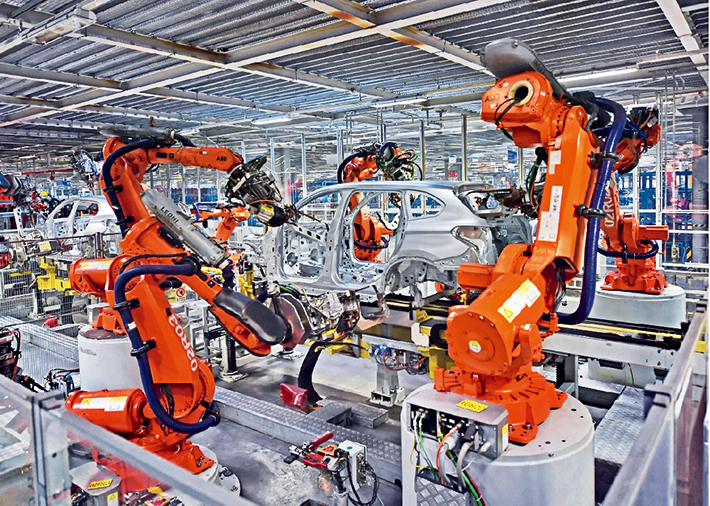|
||||||||||
| Home Top News Economy/Tech Culture/Sports China in Foreign Eyes Green Development Videos Intangible Cultural Heritages |
|
||||||||||
| Home Top News Economy/Tech Culture/Sports China in Foreign Eyes Green Development Videos Intangible Cultural Heritages |
| ChinAfrica |
| Augmented Appeal |
| China is doubling down on attracting foreign investors through broader market access and improved business environment |
| | VOL. 16 August 2024 ·2024-07-24 |

Mechanical arms conduct welding work in a workshop of the Tiexi Plant of BMW Brilliance Automotive Ltd. in Shenyang, northeast China’s Liaoning Province, on 16 February 2022 (XINHUA)
Attracting foreign capital is a key pillar of China’s reform and opening up policy, and foreign-funded enterprises are an important component of China’s economy. Currently, China is taking steps to further boost its attractiveness as a foreign direct investment (FDI) destination in order to seek more foreign capital.
FDI in China has stood at above 1 trillion yuan (about $158.89 billion) for four consecutive years from 2020 to 2023. Last year, FDI in China remained stable against the backdrop of an overall slowdown in global FDI. However, factors such as increased uncertainty in the international environment and deepening geopolitical conflicts have brought some new challenges to flows of foreign capital into China.
What is China’s current situation in attracting foreign investment? What challenges does the country face in attracting foreign investment? How will it strengthen foreign investment promotion measures to enhance the confidence of overseas investors? Chinese experts share their views on these questions.
China has been a preferred FDI destination for a long time
Wang Xiaohong
Researcher, China Centre for International Economic Exchanges
China’s political environment is stable, its economic fundamentals are sound, and the country boasts a vast market, large talent pool, and advanced infrastructure. These advantages have increased the return on investment and safety for multinational corporations. Especially since the outbreak of the COVID-19 pandemic, China has continuously rolled out policies to optimise the foreign investment environment, which has earned the trust of the multinational corporations.
China’s volume and growth rate of FDI remain at the forefront of the world. From 2012 to 2022, the average annual growth of foreign investment utilisation was 4.6 percent, exceeding the global average. In 2022, actual FDI reached $189.1 billion, an all-time high, ranking second in the world for six consecutive years. Despite a 12-percent decline in global FDI, China realised a growth of 6.3 percent. Its proportion in the global FDI rose to 14.6 percent, 11.6 percentage points higher than 2000.
Thanks to its super-large market, complete industrial chain and high-quality human resources, China has long remained attractive to foreign investors. The domestic market has become an important source of revenue for multinational corporations. At present, the share of domestic sales in the revenue of foreign-funded industrial enterprises has increased from 50 percent 10 years ago to over 70 percent; the revenue of foreign-funded information and communication technology enterprises made up 56.3 percent of the whole industry; more than 30 percent of the revenue of US semiconductor enterprises comes from the Chinese market; and the revenue of foreign-funded automobile enterprises in the Chinese market has grown.
Foreign investors’ expectations for the future remain stable with increasing confidence. Despite the intensified containment of China by the US and certain Western countries, foreign investment in China has grown. In 2023, the number of newly established foreign-funded enterprises nationwide increased by 39.7 percent. In 2022, projects funded by foreign investors exceeding $100 million grew by 15.3 percent, accounting for 53 percent of the actual utilised foreign capital.
Chinese market has outstanding advantages
Zhang Jianping
Vice President, China Research Association of Social and Economic System
Based on investment motive, foreign investment in China can be classified into two categories: cost-driven and market-oriented. Cost-driven foreign investors often regard China as a core part of the global supply chain and value chain. According to a report of the World Trade Organisation, China is, without doubt, one of the top countries in the global supply chain and value chain.
China boasts 99.9 percent of the segments among 666 minor industrial divisions in 207 medium categories under the 41 major categories defined by the United Nations. China’s manufacturing value added accounts for 32 percent of the world, indicating China’s organisational and coordination efficiency in the global supply chain and value chain. That motivates a large number of foreign investors, especially from the developed countries, to produce goods and services in China for their Asia-Pacific and global market.
Market-oriented foreign investors view China as the world’s second-largest single consumer market after the US. Not only does it have a vast market of 1.4 billion people, but it is also a growing middle-income country. In 2023, consumption contributed as much as 82 percent to China’s economic growth, highlighting the significant role of domestic demand in driving economic growth.
Additionally, investors place great importance on infrastructure. Over the past 45 years, China has built a vast amount of infrastructure. The efficiency of transportation and logistics is high, with coordinated sea, land, and air facilities, as well as robust communication support. China leads the world in infrastructure construction.
China is vigorously promoting institutional opening up, having signed 22 bilateral and multilateral free trade agreements with 29 countries. Among them, the Regional Comprehensive Economic Partnership (RCEP) covers about 30 percent each of the world’s population, economy, capital flows and trade volume.
China now has a rich talent pool. Although the demographic dividend of China’s labour force is gradually diminishing, we now have the “engineer dividend.” China’s young workers have an average of 11 years of education. Other developing countries such as India, Mexico and Vietnam cannot compete with that.
Challenges faced by China in attracting foreign capital
Tang Yihong
Dean, School of International Trade and Economics, University of International Business and Economics
Firstly, the uncertainty in the international economic environment is rising. The Global Economic Policy Uncertainty Index has been moving upwards since the 2008 global financial crisis, peaking in 2022 after the COVID-19 pandemic (above 400). China’s Economic Policy Uncertainty Index also significantly increased from below 100 in 2014 to over 700 in October 2023, nearly five times the average level before 2014.
Secondly, global investment flow is slowing down. Against the backdrop of a sharp decline in 2020 and a strong rebound in 2021, global FDI decreased by 12 percent in 2022, dropping to $1.3 trillion, according to the World Investment Report 2023. Among these, FDI in the form of international project financing transactions decreased by 25 percent, FDI in the form of cross-border mergers and acquisitions dropped by 4 percent, and the number of net cross-border mergers and acquisitions shrank by 9 percent.
Thirdly, FDI is facing important challenges because the restructuring and adjustment of global industrial and supply chains has a bearing on FDI. Due to security reasons, global supply chain, industrial chain, and value chain are becoming more regionalised, localised, and witnessing nearshoring and friendshoring. According to the Global Value Chain Development Report 2023 released by the Beijing-based University of International Business and Economics and international organisations, the length of global value chains in most industries shortened in 2021 compared to 2020.
Fourthly, high-standard international trade and economic rules set higher requirements for the investment environment. For example, high-standard trade agreements like the Comprehensive and Progressive Agreement for Trans-Pacific Partnership (CPTPP) are leading the reform of the international trading system. Compared to the RCEP, the CPTPP calls for broader opening up with greater depth.

Foreign investors attend the 12th China Electronic Information Expo opened at the Shenzhen Convention and Exhibition Centre on 9 April (XINHUA)
China’s business environment has room for improvement
China’s overall business environment is continuously improving. However, there is still a gap between China’s business environment and the global standards. Firstly, the overall business environment can be optimised, and market access restrictions in certain sectors need to be reduced. While the negative list for manufacturing in free trade zones has been reduced to zero, there are still many market access restrictions in the services sector. Additionally, intellectual property protection is still insufficient compared to international leading level. According to the World Intellectual Property Indicators, in 2022, China’s level of intellectual property protection was still in the middle globally.
China needs to raise fiscal and tax support and broaden the investment and financing channels for foreign-funded enterprises. According to the World Bank Business Enabling Environment Index, China’s credit use and tax indicators lag significantly behind the country’s overall ranking of 31st, and the gap needs to be narrowed. It is necessary to ensure national treatment for foreign-funded enterprises, make good use of special funds for promoting foreign investment, increase the publicity of relevant tax incentives for foreign-funded enterprises through online and offline platforms, accelerate the introduction of related financial products to enable foreign investors to participate in domestic investment, thereby facilitating cross-border investment and financing for foreign investors, and expand financing channels for foreign-funded enterprises by building service platforms, setting up green channels, and appropriately increasing credit issuance quotas.
It is necessary for China to reasonably lower market access restrictions in service industry and further shorten the negative list for foreign investment, so as to closely align with the high-standard international economic and trade pacts such as the CPTPP and the Digital Economy Partnership Agreement (DEPA), and leverage the advantages of various provinces, municipalities, free trade zones, and free trade ports. It is also important to further strengthen the intellectual property protection and improve mechanisms for protecting foreign investors.
China should also accelerate the formulation of rules on government procurement, labour standards, environmental protection, cross-border data flows, and cross-border taxation in line with high-standard international economic and trade pacts. It should promote institutional opening up and the construction of a unified national market and remove barriers to factor mobility.
* These views are excerpted from China Macroeconomy Forum, Outlook Weekly, and Guangming Daily.
|
||||||||||||
| About Us | Contact Us | Advertise with Us | Subscribe |
| Copyright Beijing Review All rights reserved 京ICP备08005356号-5 京公网安备110102005860号 |